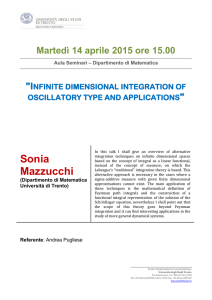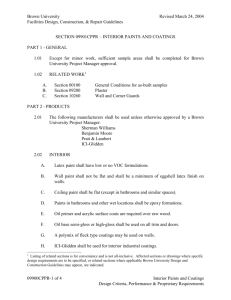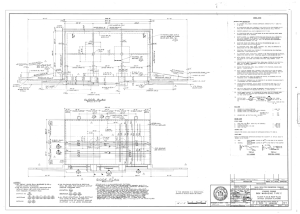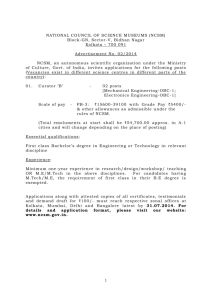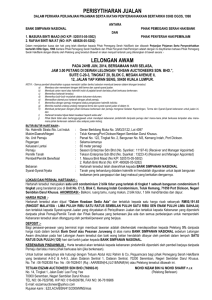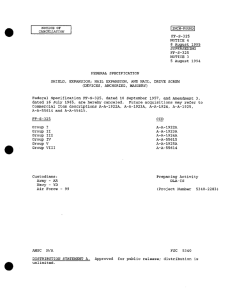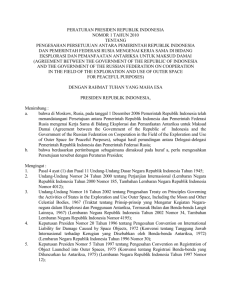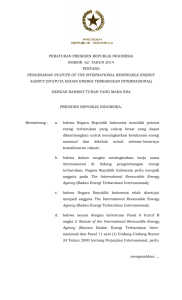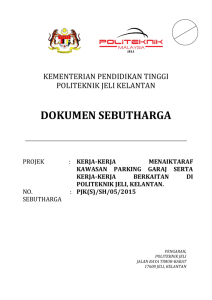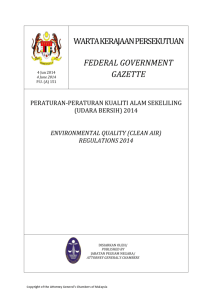Appendix 5
advertisement
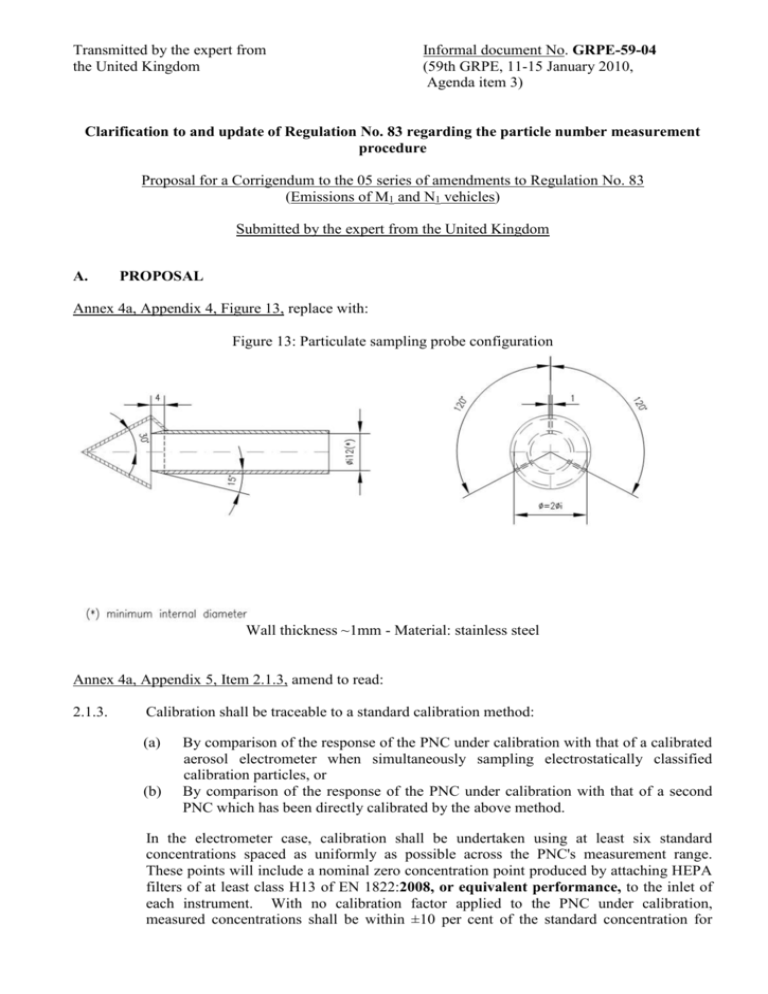
Transmitted by the expert from the United Kingdom Informal document No. GRPE-59-04 (59th GRPE, 11-15 January 2010, Agenda item 3) Clarification to and update of Regulation No. 83 regarding the particle number measurement procedure Proposal for a Corrigendum to the 05 series of amendments to Regulation No. 83 (Emissions of M1 and N1 vehicles) Submitted by the expert from the United Kingdom A. PROPOSAL Annex 4a, Appendix 4, Figure 13, replace with: Figure 13: Particulate sampling probe configuration Wall thickness ~1mm - Material: stainless steel Annex 4a, Appendix 5, Item 2.1.3, amend to read: 2.1.3. Calibration shall be traceable to a standard calibration method: (a) (b) By comparison of the response of the PNC under calibration with that of a calibrated aerosol electrometer when simultaneously sampling electrostatically classified calibration particles, or By comparison of the response of the PNC under calibration with that of a second PNC which has been directly calibrated by the above method. In the electrometer case, calibration shall be undertaken using at least six standard concentrations spaced as uniformly as possible across the PNC's measurement range. These points will include a nominal zero concentration point produced by attaching HEPA filters of at least class H13 of EN 1822:2008, or equivalent performance, to the inlet of each instrument. With no calibration factor applied to the PNC under calibration, measured concentrations shall be within ±10 per cent of the standard concentration for each concentration used, with the exception of the zero point, otherwise the PNC under calibration shall be rejected. The gradient from a linear regression of the two data sets shall be calculated and recorded. A calibration factor equal to the reciprocal of the gradient shall be applied to the PNC under calibration. Linearity of response is calculated as the square of the Pearson product moment correlation coefficient (R2) of the two data sets and shall be equal to or greater than 0.97. In calculating both the gradient and R 2 the linear regression shall be forced through the origin (zero concentration on both instruments). In the reference PNC case, calibration shall be undertaken using at least six standard concentrations across the PNC's measurement range. At least 3 points shall be at concentrations below 1,000 cm-3, the remaining concentrations shall be linearly spaced between 1,000 cm-3 and the maximum of the PNC's range in single particle count mode. These points will include a nominal zero concentration point produced by attaching HEPA filters of at least class H13 of EN 1822:2008, or equivalent performance, to the inlet of each instrument. With no calibration factor applied to the PNC under calibration, measured concentrations shall be within ±10 per cent of the standard concentration for each concentration, with the exception of the zero point, otherwise the PNC under calibration shall be rejected. The gradient from a linear regression of the two data sets shall be calculated and recorded. A calibration factor equal to the reciprocal of the gradient shall be applied to the PNC under calibration. Linearity of response is calculated as the square of the Pearson product moment correlation coefficient (R2) of the two data sets and shall be equal to or greater than 0.97. In calculating both the gradient and R 2 the linear regression shall be forced through the origin (zero concentration on both instruments). Annex 4a, Appendix 5, Item 2.2.2, amend to read: 2.2.2. The test aerosol for these measurements shall be solid particles of 30, 50 and 100 nm electrical mobility diameter and a minimum concentration of 5,000 particles cm-3 at the VPR inlet. Particle concentrations shall be measured upstream and downstream of the components. The particle concentration reduction factor at each particle size ( fr(di) ) shall be calculated as follows; N (d ) f r (d i ) in i N out (d i ) where: Nin (di) = upstream particle number concentration for particles of diameter di; Nout (di) = downstream particle number concentration for particles of diameter di; and di = particle electrical mobility diameter (30, 50 or 100 nm). Nin(di) and Nout(di) shall be corrected to consistent conditions. The mean particle concentration reduction ( f r ) at a given dilution setting shall be calculated as follows; f (30nm) f r (50nm) f r (100nm) fr r 3 It is recommended that the VPR is calibrated and validated as a complete unit. Annex 4a, Appendix 5, Item 2.3.1, amend to read: 2.3.1. Prior to each test, the particle counter shall report a measured concentration of less than 0.5 particles cm-3 when a HEPA filter of at least class H13 of EN 1822:2008, or equivalent performance, is attached to the inlet of the entire particle sampling system (VPR and PNC). Annex 4a, Appendix 5, Items 2.3.3-2.3.5, amend to read: 2.3.3. Each day, following the application of a HEPA filter of at least class H13 of EN 1822:2008, or equivalent performance, to the inlet of the particle counter, the particle counter shall report a concentration of ≤ 0.2 cm-3. Upon removal of this filter, the particle counter shall show an increase in measured concentration to at least 100 particles cm-3 when challenged with ambient air and a return to ≤ 0.2 cm-3 on replacement of the HEPA filter. 2.3.4. During each test it shall be confirmed that the evaporation tube, where featured in the system, shall indicate a reading is at a temperature of 300 °C to 400 °C. 2.3.5. During each test it shall be confirmed that the diluter PND1 shall indicate a wall temperature reading of is at 150 °C - 400 °C, but less than or equal to the set-point of the evaporation tube. B. JUSTIFICATION The proposed replacement to Figure 13 corrects an error in the current figure which appears to show the 12 mm probe diameter as being the external, rather than the internal, diameter. The proposed amendments to Appendix 5 are clarifications to the text defining the particle number measurement system specification or updates to references. These clarifications were developed in discussions on the draft proposal to insert particle number measurement procedures into UNECE Regulation No. 49. It is proposed to insert them into Regulation No. 83 in order to clarify and update the text, and to maintain consistency between texts in the two Regulations. -----

